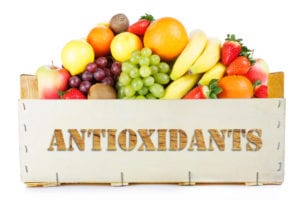Written by Joyce Smith, BS. In this pilot study, antioxidants did not appear to improve semen parameters or DNA fragmentation among men with male infertility and suggests that antioxidants do not improve pregnancy rates in cases of in vitro fertilization or in vivo conception.
 Previous studies have linked antioxidant use to improvements in sperm motility, DNA integrity, and pregnancy rates in couples undergoing assisted reproductive technologies. Vitamin E 1, selenium 2, N-acetylcysteine 3 and carnitine 4 have been shown to improve semen parameters and Vitamin C and E have reduced DNA fragmentation 5. However, all of the studies used small sample sizes of usually less than 50 subjects, heterogeneous populations, a variety of single antioxidants, and changes in semen parameters or DNA integrity as the endpoint, rather than clinical outcomes. In addition, when assessing antioxidant effectiveness, they used antioxidants along with in vitro fertilization with intracytoplasmic sperm injection (ICSI). This study was designed to hopefully improve upon previous studies by filling in knowledge gaps and providing stronger evidence for antioxidant use, both as a standalone and in conjunction with in vitro fertilization and ICSI.
Previous studies have linked antioxidant use to improvements in sperm motility, DNA integrity, and pregnancy rates in couples undergoing assisted reproductive technologies. Vitamin E 1, selenium 2, N-acetylcysteine 3 and carnitine 4 have been shown to improve semen parameters and Vitamin C and E have reduced DNA fragmentation 5. However, all of the studies used small sample sizes of usually less than 50 subjects, heterogeneous populations, a variety of single antioxidants, and changes in semen parameters or DNA integrity as the endpoint, rather than clinical outcomes. In addition, when assessing antioxidant effectiveness, they used antioxidants along with in vitro fertilization with intracytoplasmic sperm injection (ICSI). This study was designed to hopefully improve upon previous studies by filling in knowledge gaps and providing stronger evidence for antioxidant use, both as a standalone and in conjunction with in vitro fertilization and ICSI.
One hundred and seventy-four couples were enrolled in a multi-center, double blind, randomized, placebo-controlled trial 6 of a daily antioxidant formulation containing 500mg vitamin C, 2000IU vitamin D3, 400IU vitamin E, 1mg folic acid, 20mg zinc, 200mcg selenium, and 1000mg L-carnitine. Males with sperm concentration ≤ 15 M/ml, motility ≤ 40%, normal morphology ≤ 4%, or DNA fragmentation > 25% were eligible. Female partners were ≤ 40 years old, with documented tubal patency and ovulation. Semen parameters and DNA fragmentation were assessed at randomization and following three months of treatment. Males were treated for a minimum of three months with antioxidants during which time couples attempted to conceive naturally, or six months with antioxidants during which time they received clomiphene citrate with intrauterine insemination in months four through six.
At three months, results showed only a slight overall difference in sperm concentration between the two groups, and no significant differences in morphology, motility, or DNA fragmentation measurements. Sub-group analysis (according to different types of sperm abnormality) found no significant differences in sperm concentration in the 66 oligospermic (low sperm) men (p=0.30), or motility in the 76 asthenospermic (low sperm motility) men (p=0.93), or morphology in the 40 teratospermic (abnormal morphology) men (p=0.28). In addition, no changes were evident in men with high rates of DNA fragmentation (28.9% in the antioxidant group versus 28.8% in the placebo group). When considering the entire cohort, natural conception during the three month trial was similar between the two groups with a pregnancy rate of 10.5% in the antioxidant group and 9.1% in the placebo. At six months, even after continued antioxidant or placebo for the male partners and three cycles of clomiphene and intrauterine insemination for the female partners, pregnancy rates remained unchanged.
While the trial was small, it was adequately powered to examine changes in semen parameters; however, it was underpowered to assess differences in pregnancy rates between antioxidants and controls. Thus, given the absence of significant changes in semen parameters, the safety monitoring board recommended that researchers not continue with the anticipated larger trial.
Source: Steiner, Anne Z., Karl R. Hansen, Kurt T. Barnhart, Marcelle I. Cedars, Richard S. Legro, Michael P. Diamond, Stephen A. Krawetz et al. “The effect of antioxidants on male factor infertility: the Males, Antioxidants, and Infertility (MOXI) randomized clinical trial.” Fertility and Sterility (2020).
© 2019 by American Society for Reproductive Medicine.
Posted November 9, 2020.
Joyce Smith, BS, is a degreed laboratory technologist. She received her bachelor of arts with a major in Chemistry and a minor in Biology from the University of Saskatchewan and her internship through the University of Saskatchewan College of Medicine and the Royal University Hospital in Saskatoon, Saskatchewan. She currently resides in Bloomingdale, IL.
References:
- Ener K, Aldemir M, Işık E, et al. The impact of vitamin E supplementation on semen parameters and pregnancy rates after varicocelectomy: a randomised controlled study. Andrologia. 2016;48(7):829-834.
- Scott R, MacPherson A, Yates RW, Hussain B, Dixon J. The effect of oral selenium supplementation on human sperm motility. British journal of urology. 1998;82(1):76-80.
- Ciftci H, Verit A, Savas M, Yeni E, Erel O. Effects of N-acetylcysteine on semen parameters and oxidative/antioxidant status. Urology. 2009;74(1):73-76.
- Smits RM, Mackenzie-Proctor R, Yazdani A, Stankiewicz MT, Jordan V, Showell MG. Antioxidants for male subfertility. Cochrane Database Syst Rev. 2019;3(3):Cd007411.
- Greco E, Iacobelli M, Rienzi L, Ubaldi F, Ferrero S, Tesarik J. Reduction of the incidence of sperm DNA fragmentation by oral antioxidant treatment. Journal of andrology. 2005;26(3):349-353.
- Steiner AZ, Hansen KR, Barnhart KT, et al. The effect of antioxidants on male factor infertility: the Males, Antioxidants, and Infertility (MOXI) randomized clinical trial. Fertil Steril. 2020;113(3):552-560.e553.
